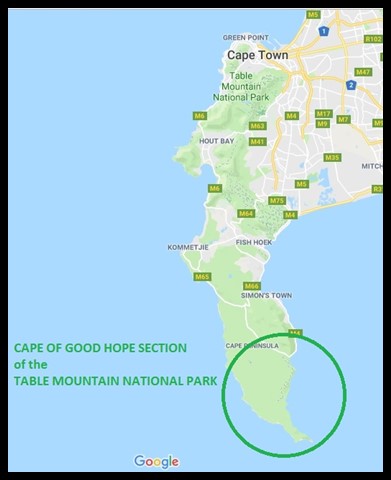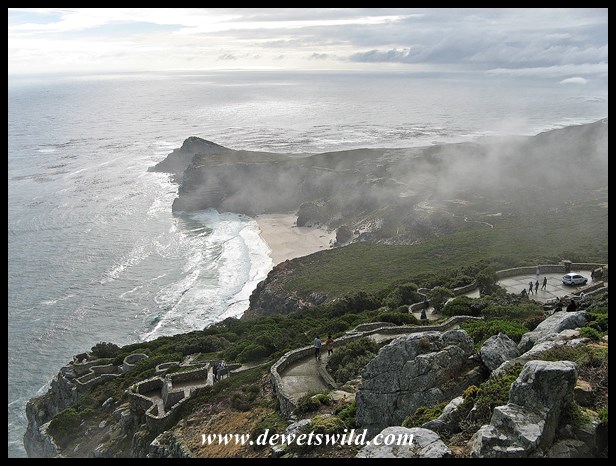Archaeological investigations indicate that the Cape Peninsula, the mountainous promontory that stretches for over 50km from Table Mountain in the north to Cape Point in the south at Africa’s south-westernmost extremity, has been inhabited intermittently by humans since the Early Stone Age, roughly 600,000 years ago. First described as the “Cape of Storms” by Portuguese explorer Bartolomeu Dias, the first known European to navigate around the southern tip of Africa in March 1488, and then given the moniker “Cape of Good Hope” by King João II of Portugal as Dias’s “discovery” opened the possibility of an oceanic trade route to India and the Far East, the most flattering description for this stretch of rugged coastline came from English Admiral Sir Francis Drake in 1580, when he referred to it as “a most stately thing and the fairest cape we saw in the whole circumference of the earth“. Today, two “padrãos” – replicas of the limestone pillars erected by Portuguese explorers on their voyages to signify Portuguese and Christian sovereignty and erected in 1965, commemorate two of those erstwhile explorers: Dias and Vasco da Gama, the first to reach India from Europe around the African coast.
In 1939, the Cape of Good Hope Nature Reserve was established on the southern tip of the Cape Peninsula. In 1998, the reserve’s 7,750ha was incorporated into the Cape Peninsula National Park, which was renamed the Table Mountain National Park in 2004. The land area of the Park covers a total of almost 300km², with a further 975km² of the ocean protected in a marine reserve. Managing this National Park with Cape Town and its suburbs, a city of 3,7-million people, right on the doorstep must be a daunting task and with over 4-million visitors annually, the Table Mountain National Park is one of South Africa’s top tourist attractions.
Cape Point consists of dramatic sea cliffs, among the highest in the world, jutting into the Atlantic Ocean at the tip of the Peninsula. On a clear day the view from the top is nothing short of spectacular. The “Flying Dutchman” Funicular (named for Captain Hendrick van der Decken’s ghost ship still plying these waters in stormy seas) is available to take visitors up to the old lighthouse and viewpoints and back down, though there’s always the option of hiking the 800m distance.
Commonly described as Fynbos, the natural vegetation of the Table MountaIn National Park is an integral component of the Cape Floral Kingdom, which, with an amazing 9,004 plant species is the smallest of only 6 plant kingdoms recognized in the world and a UNESCO Natural World Heritage Site. There are over 2,285 indigenous flowering plant species on the Cape Peninsula – compare that to fewer than 1,500 species indigenous to the entire British Isles! Inside the Cape of Good Hope section of the Park alone, over 1,200 plant species have been identified.
The Cape Peninsula may be world renowned for its awesome scenery, but it is also home to a wide variety of birds (303 species on land and sea), mammals (58 terrestrial and 36 marine species) , reptiles (64 species), amphibians (17 species) and fish (including the Great White Shark), not to mention countless invertebrates.
Visitors may overnight inside the Cape of Good Hope section of the National Park at one of three cottages (Olifantsbos, Eland & Duiker) or on the Hoerikwaggo Cape of Good Hope Trail. An extensive network of tarred roads lead to several viewpoints and picnic sites, two of which have tidal pools as swimming in the sea at many of the beaches here is considered rather risky, while a restaurant and curio shops can be found at Cape Point.
We spent two nights at Eland Cottage at the Cape of Good Hope during our epic December holidays in eight of South Africa’s national parks.
The Cape of Good Hope section of the Table Mountain National Park lies to the south of the city of Cape Town, and can be approached either from the town of Kommetjie along the Atlantic seaboard (road M65), or through Simon’s Town on the False Bay coast (road M4 / M66).





























































Great selection of shots!! I would say you pretty well comprehensively covered our wild and wonderful Cape!
LikeLike
Thanks very much, Liz. We went away from the Cape of Good Hope with a real sense that we still have lots of reasons to return!
LikeLiked by 1 person
Fabulous! Are there Penguins in this part of the world?
LikeLike
Indeed there are, Alanna. Have a look at our latest post: https://dewetswild.com/2018/01/11/boulders-beach-and-penguin-colony/
LikeLike
Ons hoop hulle kry gou goeie reën
LikeLiked by 1 person
O beslis, Tina. Dit kan afstuur op n ramp.
LikeLiked by 1 person
I have had a fascination with the Cape of Good Hope since studying history in primary school. Your pictures feed that fascination. Although I’ve seen many photos of Table Mountain and the spectacular view from the top, this post gives a different view of the park area – all of it beautiful.
LikeLiked by 1 person
Thanks Joanne! I think for me the Cape of Good Hope reserve, and Cape Point especially, is even more beautiful than Table Mountain as the views are clear of human development…
LikeLiked by 1 person
Beautiful pictures! You give a different version of South Africa than I think most of us do not know. Television and news angles mostly wrong. Incredibly beautiful scenery!😊
LikeLiked by 2 people
Thanks John. We have our societal problems in South Africa, as I think does every country in the world, but overall our people love each other and love our country – but that doesn’t sell newspapers.
LikeLiked by 1 person
Van al die pragtige foto’s is my gunsteling die een van die De Wets – o, en van die veldblommetjie ook!
LikeLiked by 2 people
Dit is baie gaaf van jou, dankie Tannie Frannie!
LikeLiked by 2 people
Beautiful photos…except for the sea lice.
LikeLiked by 2 people
Thanks Joseph. I found the sea lice most interesting actually – there were literally millions of them, all moving towards the sea as the tide was pulling back. A sight to behold!
LikeLiked by 2 people
Still makes me itchy.
LikeLiked by 2 people
Dries, thank you for this post. It is so interesting and filled with good information and photos.
LikeLiked by 2 people
It is my pleasure, Hien! We love showing off our beautiful wild places.
LikeLiked by 1 person